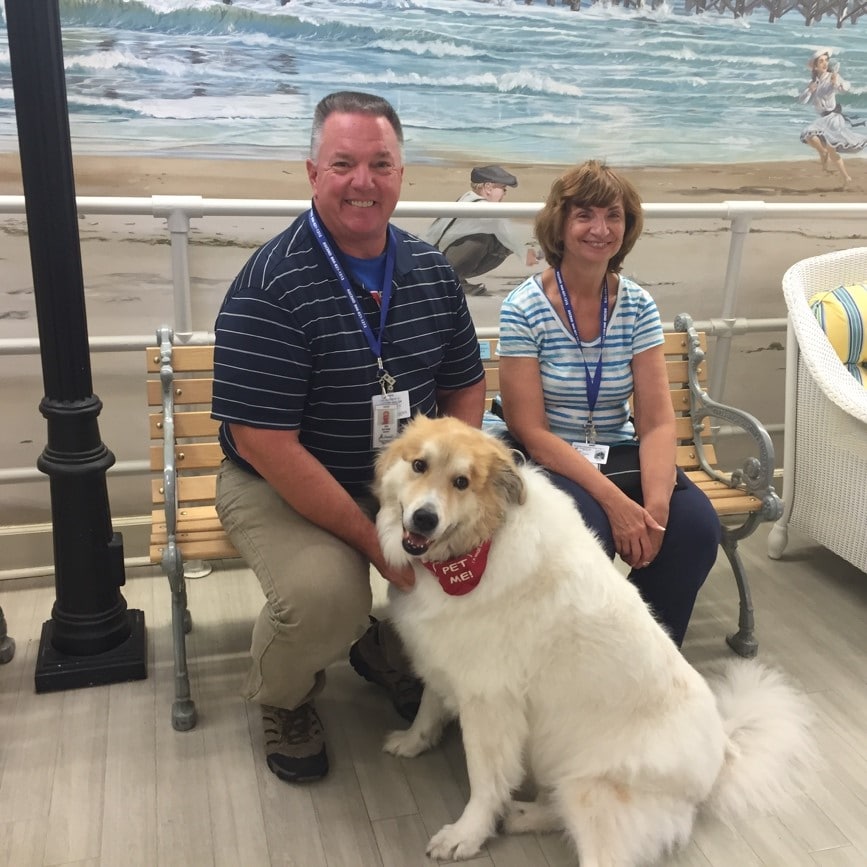Among the many visitors who used to frequent Seashore Gardens Living Center, few can compare to this four-legged favorite. Pet therapy can brighten anyone’s day!

When Sue Walsh says the word, “work,” Blizzard is ready to go. He heads to the door, knowing that he’ll soon be cuddling with his friends at Seashore Gardens Living Center (SGLC), though cuddling might not be the right word for this 90-lb. Great Pyrenees mix.
“Blizzard actually is the perfect cuddler,” explains owner Sue Walsh. “He’s the ideal height for beds and wheelchairs. He can lay his head in a resident’s lap if they wish, and he’s easily accessible for petting. They just love petting him. He’s got such a lush coat.”
Sue and Bob Walsh are volunteers for Ascend Hospice. Before the pandemic, they would visit SGLC weekly with Blizzard. “We would have 4-5 people on the hospice list, but we didn’t limit our visits to the list. The recreation staff might say, ‘so-and-so was having a bad day; could you stop by and see him?’ We’d also be stopped many times on our way to the rooms and Blizzard always obliged. We would get to Seashore Gardens at 6 pm and wouldn’t leave until 8 pm.”
The couple wouldn’t have it any other way. They find volunteering to be the relaxing break that they need from their jobs and stressful lives. “We’ve been working with therapy dogs for 20 years,” said Sue. “Blizzard is our fourth therapy dog. He’s a member of Bright and Beautiful Therapy Dogs, which certifies and insures the animals.” In addition to visiting SGLC, Sue and Bob take him to Stockton University, Shore Memorial and the National Guard Center. “He’s smart enough to know where he is, and what is appropriate,” says Sue.
The Benefits of Animal Therapy
The visits from Blizzard and other animals offer a real benefit to residents.
“Research has shown that visits from pets are more than just fun,” said Executive Director Alysia Price, LCSW, LNHA, CALA, CDP. “Petting a dog can decrease levels of stress hormones, regulate breathing and lower blood pressure. It also releases oxytocin, a hormone associated with bonding and affection in both dogs and people.”
It’s very evident when Blizzard makes his way through Comfort Care, SGLC’s dementia neighborhood. “You can feel the tension turn down as he works his way around the room,” said Sue. “It’s incredible the effect that he has on them.”
Making Lasting Connections
The bonds are real and lasting. “There was a lovely man we visited for almost a year but he has since passed,” recalls Sue. “He was blind. As soon as he touched the dog, he knew him. He would completely engage with us for 10 minutes, talking to Blizzard and telling him how beautiful he was.”
“There was a woman who was a former teacher in the Ocean City School System,” she adds. “She talked about her teaching and love of sports. Another woman talked about the dog she had. You get to know people. Even if we’re there for 10 minutes, you can see a difference in the person. They’ll talk to the dog, and start to relax.”
For the past year, Sue and Bob have kept SGLC updated with pictures of Blizzard and messages. The greetings are posted on the bulletin board for the residents to see, and to know that this special trio has not forgotten them.
“We get a fondness for the people we visit,” says Sue. “We miss seeing them. It’s like you’re visiting with family. Not only do we look forward to those visits but Blizzard does as well. We can’t wait to be back to work.”
Blizzard’s ears perked up when she mentioned the word, ‘work.’ “Blizzard is so used to working,” she says. “He can’t understand why we’re sequestering him.”


